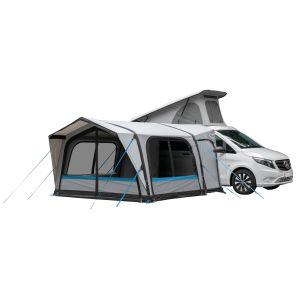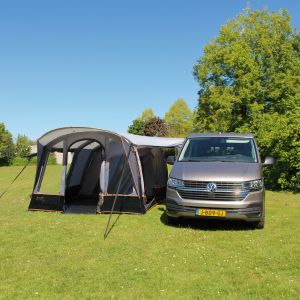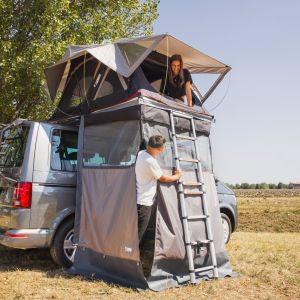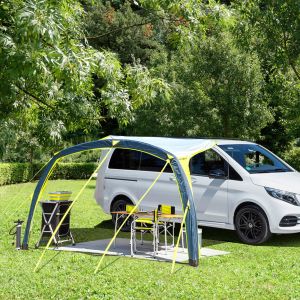Van Awnings
Clever van awnings More space when camping!
We love going on holiday with our camper van or van. But once we’ve reached our destination, just one more “room” would often be incredibly convenient. For eating together, perhaps for extra sleeping space or simply as protection from the sun and rain.
That’s exactly what our versatile van awnings are for. Depending on your needs, we offer them in many different sizes – some are inflatable, some freestanding and some even come with an integrated sleeping cabin. What kind of extra room would you like? With our tips, you will quickly find your perfect van awning.
It all depends on the height
Whether you have a transporter, a van or a VW bus – awnings are a great way to increase living space for almost all vehicles. However, you should pay attention to the height of your camping vehicle so that you can attach your new awning without a problem. Our awnings for vans are available in different mounting heights – for campers generally from 180 - 220 cm, for vans from 240 - 280 cm. If you choose the correct height, your awning will fit your vehicle perfectly – and wind and weather won’t stand a chance!
How big should your van awning be?
Do you like to travel with all your favourite people? Then you should take a closer look at our large awnings. In addition to practical sleeping cabins, they often offer extra areas for cooking or eating together. Once you have set up the awning, you can lean back and enjoy the extra space in front of your comfy holiday home.
For couples and solo travellers, awnings offer that little bit extra. They are small and compact when stowed away, but quickly set up again if you need an extra room. Whether it’s for a dining table, a cosy camping lounger or simply for more privacy on the campsite – an awning is always a good choice!
It couldn’t be easier – inflatable awnings for campers
Our van awnings are incredibly practical! They are set up in no time but won’t fall easily. We love them! Thanks to modern technical developments, these awnings are super stable and can withstand both wind and weather. With an electric pump, you can set up your additional living space quickly. Because let’s be honest, the sooner the fun can start, the less reason there is for arguments with your loved ones – such as a marital quarrel when setting up the tent.
How do you attach an awning like that to your van?
Which attachment method is the right one for your new awning depends on what your vehicle is equipped with.
1. Attachment to a piping rail
Awnings with piping rails can be easily pulled into the piping rail of your van. You can do that even when you’re travelling alone. And with two people, it’s child’s play. You can also use a piping adapter.
2. Attachment to a roof rail
A roof rail is incredibly practical. If you have one, you can easily attach your awning to your van. Or you can attach a piping adapter to the rail and use an awning with a piping rail. But please pay attention to the mounting height of the awning.
3. Attachment to a canopy
You already have a canopy on your camper van and want to attach an awning? That’s not a problem, either. If the van awning is equipped with a 5 mm piping – which is the case with most – you don’t even have to remove the canopy. That’s because all canopies have a piping rail for 5 mm pipings in the front panel, so all you have to do is pull your new awning into the piping rail.
4. Attachment via connecting pole
These awnings are attached with a so-called connecting pole. For example, to the gutter or to the roof rail. The pole is pushed into the hollow space of the awning, placed over the gutter or roof rail and attached to the vehicle with clamps, suction cups or magnetic straps. It fits like a glove! Since this often creates a dry and wind-protected connection between the van and the awning, the pole is called a connecting pole.
For minimalists: pack size & weight
If your van is already bursting at the seams because of camping accessories, it’s best to choose an awning with a small pack size. They are lighter and therefore quicker to set up and dismantle. Especially for campers who like to travel from one place to the next when they are on holiday, a smaller awning with a small pack size is ideal.
Freestanding van awnings
Do you like exploring your surroundings when you’re on holiday? Then we recommend using a freestanding van awning. Why is it so great? Because you can simply “drive away” your van and your awning will stand all on its own. Depending on the model, your awning can be easily closed. This ensures that you can leave your camping equipment such as your table, chairs and barbecue at the campsite while you go exploring. You kill two birds with one stone. Your belongings are protected from the rain and newcomers can’t take over your favourite spot while you’re away.
What can you do with a van awning?
Rear tent or side extension – everything is possible!
Many of our practical van awnings can be used in a variety of ways.
Side expentension
Most campers attach their “extra room” to the side of their motorhome. And voilà, more living space is available. They create a cosy, weather-protected dining area and integrate their outdoor kitchen or camping wardrobe. At night, the room transforms into a cosy sleeping place for the kids – or the snoring partner.
Rear tents
However, van awnings can also be used as rear tents. This is, for example, ideal for your van if you have a rear kitchen on board. Completely protected from the rain, you can prepare and enjoy your delicious camping meals. Many campers also appreciate rear tents because they increase their privacy. Enjoy more space for getting changed or for your comfy deck chair.
Good to know: material & outdoor durability
Choosing the material of your awning depends on where you want to travel.
Many awnings are made of practical polyester. They are lightweight, tear-resistant and have a high UV resistance. Depending on the coating, an awning can be made even more weather-resistant:
PU coating
Polyurethane is cold-resistant, particularly waterproof and is used for awnings and groundsheets alike.
PVC coating
A polyvinyl chloride coating makes your awning waterproof and tear-resistant.
Sealed seams – or taped seams – provide extra protection for your awning. This is especially important when you are travelling in rainy regions.
… Low-budget awnings
For those new to camping and those only travelling in the summer, awnings without a groundsheet are a good choice. The hydrostatic head can also be a bit lower when used in dry regions. This way, you can save on your budget without having to do without the usual Frankana Freiko quality.
Our tip : If necessary, you can also put an extra groundsheet or a camping carpet in your awning later.
Tip
If you are primarily travelling in warm, summery climes, an uncoated awning is often sufficient. They are lighter and more practical for daily use.
For extra comfort or extreme weather situations, it is definitely worthwhile to buy an awning with a high hydrostatic head (at least 4000 - 6000 mm) and taped seams.
Sleeping
If you need an extra “bedroom”, you should choose a van awning with a sleeping cabin that can be hooked in. Mosquito nets in the window areas make your camping life even more enjoyable – especially in warm places, we love the fresh breeze at night, while protective fly screens protect us from annoying mosquitoes. And speaking of “windows”, if you like it bright and friendly, choose an awning with a few transparent windows. If you wish, you can, of course, simply close them in the evenings by rolling down the “shutters”.
Technical terms simply explained
- What is a hydrostatic head?
The hydrostatic head tells you how waterproof a tent is. The value is given in millimetres and measures how much water pressure the tent fabric can withstand. If you use your tent mainly in the summer, a hydrostatic head of at least 2000 mm is recommended. If you also want to go camping during the rest of the year, you should opt for a tent with a hydrostatic head of at least 3000 mm. And when travelling to rainy areas, such as Norway, we recommend a tent with a hydrostatic head of at least 4000 mm. - What is the pack size?
The pack size tells you how much space a product takes up when it is folded or rolled up. - What are taped seams?
Special seam-sealing tape seals the leaky spots caused by the sewing process – e.g. small puncture holes in the flysheet made by the sewing needle – so that moisture cannot get in. - What is a connecting pole?
A connecting pole is a pole you can use to attach your van awning to your vehicle. - What is the mounting height?
The mounting height is important when it comes to choosing the right awning. It is the distance from the ground to the piping rail or roof edge of your camping vehicle.





























